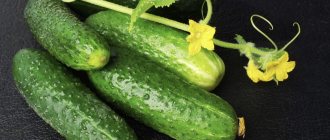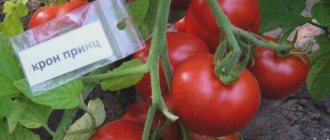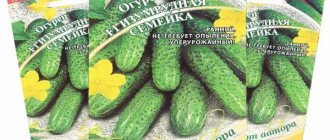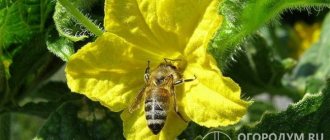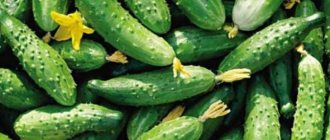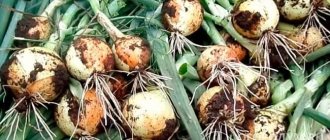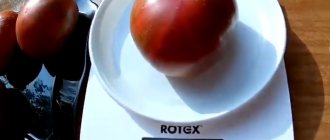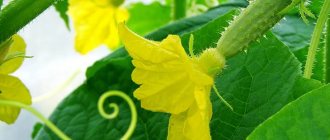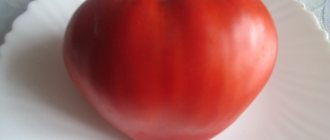Claudine F1 cucumbers will appeal to those who have already tried to grow the Claudius F1 hybrid, because they were created on its basis in order to improve an already excellent variety. Thanks to this, the hybrid is easy to care for, resistant to diseases, and has excellent yield and taste.
| Landing location | Ripening time | Mode of application | Fruit length | Group | Fruit smoothness | Pollination method |
| Universal | Early ripening (35-45 days) | Salad | Medium - from 10 to 15 cm | Hybrid | Slightly lumpy | Parthenocarpic |
Characteristics and description of the variety
Claudine F1 cucumbers are a hybrid with a very early period of fruit ripening. This hybrid was bred on the basis of an earlier hybrid variety of Claudius F1 cucumbers. Selection work was carried out by the Dutch agricultural company Royal Sluis. Claudine F1 is intended for growing in greenhouses and outdoors. The hybrid is parthenocarpic, its flowers are only female in nature, therefore they do not require pollinators (bees, flies, ants) to form an ovary.
The high yield of this hybrid is explained by such an important characteristic as bunch fruiting. The hybrid calmly reacts to high temperatures in closed structures without shedding flowers or ovaries. This hybrid is suitable for growing in the south, as well as in temperate climates. In the northern regions, it can only be grown under film covers, optimally if the greenhouses are equipped with a heating system.
The above-ground bush of the plant is powerful, the vines are long, not too dense, but covered in sufficient quantities with leaves. The leaves are wide, rounded, divided into five segments. Painted in bright green. The lower and upper parts of the leaf plate have a rough structure. The leaves are often located on the main and side branches. In the axil of each leaf, the plant forms a bunch of ovaries, consisting of 5–6 greens.
Did you know? Cucumber fruits are 90% water, so eating the vegetable in the morning after an alcoholic party can help a person suffering from a severe hangover.
The plant blooms with large yellow flowers, up to 3 cm in diameter. Claudine F1 is relatively resistant to diseases such as powdery mildew and cucumber mosaic. The bush is slightly affected by cladiosporiosis. Without the vegetable grower observing disease prevention and proper cultivation techniques, the plant can still get sick.
Botanical description of the bush and fruits
Cucumber is a tropical perennial herbaceous plant whose Latin name is Cucumis sativus. This plant belongs to the pumpkin family. Wild varieties of cucumber have a stem with an unlimited growth point and a well-developed root system. The plant absolutely cannot tolerate sub-zero temperatures, so in our country the crop is grown as an annual.
Find out the benefits and harms of cucumbers.
In cultivated agriculture in many countries, productive varieties and hybrids of cucumber are grown, obtained through selection. Only young fruits of this crop are eaten by people. They are eaten fresh, salted, pickled, stewed and even fried.
Fruitfulness
Claudine F1 quickly grows small gherkin fruits; the weight of a well-formed cucumber does not exceed 85 g. The skin on the fruits is dense, but elastic and thin, green in color, covered with small tubercles without spines. The diameter of ripened fruits does not exceed 3.5 cm. The pulp of cucumbers is crispy, juicy, and has no bitterness.
The fruits of this hybrid are dense and do not form voids in the pulp. Cucumbers are distinguished by marketability; ugly or poorly formed fruits occur in no more than 5% of the total mass of the crop. By observing all the conditions of agricultural technology, a vegetable grower can collect up to 10 kg of fruit from every 1 m² of greenhouse. In open ground, the yield is slightly lower and reaches 9–9.5 kg per 1 m².
Ripening and flowering dates
This hybrid begins to bloom 30 days after the appearance of cucumber sprouts on the soil surface. If the temperature regime is observed, the gardener can receive the first fruits after 38–40 days of the crop’s growing season.
Cucumber “Claudine f1”: improved qualities of the popular variety “Claudine F1”
The early improved parthenocarpic hybrid of cucumber-gherkin “Claudine-f1” is an achievement of the very famous and popular company Royal Sluis among vegetable growers.
Description of the variety
For a long time, it was the “Clavdia” variety that was popular among Russian gardeners, because formed “thin-skinned”, with a pleasant and refreshing dessert taste, elegant and “miniature” greens.
The plant forms medium-sized bushes, with well-growing shoots and bunched ovaries. The bushes are not only powerful, but also quite open, which makes caring for the plant and harvesting much easier. The foliage is lush and powerful.
The fruits do not exceed 10-12 cm in length and have a cylindrical shape, as well as a lumpy surface with a pronounced green color. All greens have a uniform shape, high quality indicators and a dense consistency. The average weight of one commercial herb is 85 g. The pulp is without bitterness, juicy and very crunchy, not only fresh, but also after processing. The variety is very productive, the greens are tasty, sweet, crispy, with an ideal shape.
Landing rules
Cucumber variety "Claudine f1" requires the preparation of loose, fertile and porous soil. By the time the seeds are sowed, night temperatures should not fall below 8-10°C. The hybrid form is recommended for cultivation on ridges in glass and film greenhouses, as well as tunnels. Cultivation in open ground is also allowed. You can use both vertical and horizontal growing methods.
The variety has proven itself very well in spring-summer crop rotation. Depending on the fertility of the soil, mineral fertilizers in the form of 20-25 g of ammonium nitrate, 30-40 g of superphosphate and 15-20 g of potassium sulfate per square meter should be applied a couple of weeks before sowing the seeds.
The sowing pattern is 50x30 cm with a sowing depth of 2-3 cm. In order to protect against late frosts, it is recommended to temporarily cover early sowings with film on the arches.
Features of care
Gardeners note the unpretentiousness of the Claudine f1 cucumber, as well as its high level of resistance to a variety of unfavorable natural factors. To get a good harvest without significant material and physical costs, you need to follow these simple recommendations:
- if necessary, after the emergence of seedlings, the plants should be thinned, and the weakest ones should be removed;
- during the fruiting phase, the soil should be moistened quite abundantly, from the standard calculation of about 2.5-3 liters per square meter;
- In case of insufficient development and growth, it is recommended to feed cucumber bushes with any nitrogen fertilizer, including urea, ammonium or potassium nitrate, as well as ammophosphate at the rate of 8 g per bucket of water.
The main measures for caring for cucumbers include, in addition to thinning, watering and fertilizing, also loosening the soil, weeding, pinching shoots in order to form the plant and increase productivity. Harvesting is carried out as the greens ripen, which contributes to longer and more abundant fruiting.
The cucumber variety “Claudine f1” has earned the most laudatory reviews, so it has every chance to take an honorable place among the most beloved hybrid forms among Russian gardeners. The hybrid is characterized as mid-season and very resistant to a whole range of diseases, and also guarantees high yield. Greens of this hybrid are ideal for pickling, canning and fresh consumption.
The variety is very reliable, has excellent germination and even in lean years produces quite a lot of marketable gherkins. Strict adherence to all agrotechnical care requirements during the growing season guarantees yields, which are often even higher than those declared by the seed manufacturer.
Advantages and disadvantages of the variety
The cucumber hybrid Claudine F1 is very popular among farmers and private vegetable growers who grow early produce. The hybrid has many positive qualities.
- Advantages of the variety:
- high yield, which is facilitated by the fascicle ovary;
- small fruit shape;
- storage ability for 10–14 days;
- lack of tendency to overgrow fruits;
- resistance to the most common cucumber diseases.
- Disadvantages of the variety:
- the need to purchase seeds annually;
- high cost of seed material.
Sowing and agrotechnics of cultivation
This hybrid is ideal for growing in greenhouses and open ground. But it is necessary to take into account the fact that cucumbers ripen much earlier in a greenhouse; their yield increases significantly, since the fruiting time during the season increases. This is due to the fact that cucumber seedlings can be planted in a greenhouse in early spring. Cucumbers can be sown in open ground at the end of April; their growing season will continue until mid-July.
Experienced vegetable growers recommend planting 2-3 cucumber plants per 1 m²; this density is necessary to maximize the use of land and achieve high fruiting from each bush. This crop does not tolerate low temperatures; even at air temperatures below +10°C, plants stop growing and soon begin to get sick. Before fruiting begins in the greenhouse, it is important to maintain a certain soil temperature regime: at least +10...+12°C.
Important! Vegetable hybrids acquire almost all the positive characteristics from their parents, which explains their high yield. But the vegetable grower needs to remember that seeds cannot be collected from the first generation hybrid (F1) for sowing next year, since they do not retain parental qualities and partially remain infertile.
Regardless of where the bed intended for cucumbers will be located (in a greenhouse or outdoors), the soil must be properly prepared before planting seedlings or sowing seeds. It is very important to add nitrogen and calcium to the cucumbers. Cattle manure can be used as nitrogen fertilizer, and wood ash can be used as calcium.
For 1 m², 10 kg of manure and 200 ml of ash are enough. Manure is spread on the surface of the soil, after which it is dug as deep as possible with the soil. Ashes are added by sprinkling the dug-up soil on top and mixing it with the soil with a rake.
In the open ground
Cucumbers are sown in the garden when stable heat develops outside and the soil temperature at a depth of 20 cm is at least +12°C. In the middle zone, this period usually falls in mid-May, depending on the weather. In the south, sowing work is carried out several weeks earlier. In the north, in the risky farming zone, cucumbers are sown only in early June.
Did you know? In the Middle Ages, European healers treated patients with cucumbers, since these fruits were considered a good diuretic and laxative.
Sowing seeds in a garden bed is carried out as follows:
- Furrows are made in the prepared bed for sowing seeds. It is convenient to make furrows using the side angle of the hoe blade. The depth of the furrows should not exceed 5 cm.
- If the bed is wide, at least 120 cm wide, you can sow 2 rows of cucumbers on it. To do this, create 2 furrows parallel to each other with a distance of 60 cm from each other. Only 1 row of cucumbers is sown in narrow beds.
- Planting furrows are watered abundantly, using at least 1 liter of water per meter of furrow.
- After the water is absorbed into the ground, the seeds are laid out along the center of the depression. In a narrow bed, where plants will be grown in one row, the seeds are laid out at a distance of 10–15 cm from each other. When growing 2 rows of plants in one bed, the seeds are laid out at a distance of 30 cm from each other.
- Using a hoe or other garden tool, cover the seeds with soil flush with the rest of the surface of the bed. The soil is slightly compacted, after which the crops are watered again (moderately).
- To prevent the soil in the garden from losing moisture so quickly, the surface of the soil is covered with spunbond, which will also act as a warm “blanket” for the crops.
Cucumber seeds can be sown either dry or sprouted.
Germination of seeds is done in order to speed up the process of the appearance of cucumber sprouts on the soil surface. Important! To germinate cucumber seeds, you need to take only sawdust obtained from deciduous trees. Coniferous wood contains inhibitory substances that prevent rapid seed germination.
How to germinate cucumber seeds:
- Before germination, the seeds are disinfected in a solution of water and manganese (1 g of potassium permanganate per 1 liter of water), then dipped in a growth stimulator for 15 minutes. This can be either a homemade growth stimulator (warm water with honey, aloe juice) or purchased at a garden store, “Emistim”).
- Next, the seeds are removed from the growth stimulator and wrapped in damp woolen cloth for a day.
- After the soaking period, the seeds are placed in a bag or container with wet sawdust. The seeds should be covered with sawdust on top and bottom. The bag with sawdust and seeds is placed in a warm place for 3 days.
- When sowing, the sprouted seeds are placed very carefully in a damp furrow in the soil, trying not to break the fragile, barely formed sprouts and roots.
In the greenhouse
Indoors, cucumbers are grown in greenhouses (heated and unheated) and greenhouses. Growing in closed ground allows you to get an early harvest of vegetables, sometimes several weeks earlier than in an open ground garden. Since heating such structures is a rather difficult and expensive process, gardeners prefer to plant adult seedlings in greenhouses.
Did you know? Medieval beauties used cucumber pulp to whiten the skin of their faces and hands.
Growing cucumber seedlings goes like this:
- White river sand, fertile chernozem and humus or compost are mixed in equal parts. To these ingredients add 0.5 liters of sifted wood ash. All parts are mixed well, after which the soil mixture is ready for sowing.
- The gardener needs to remember that cucumbers, like other members of the pumpkin family, cannot tolerate having their root system disturbed. That is why seedlings of these crops need to be grown in containers whose walls decompose in the ground. The seedlings are planted in a permanent place along with the pot in which it grows. Subsequently, the walls of the pot will become damp in the soil and become permeable to growing roots. Pots made of humus or peat are best suited for these purposes.
- There should be a hole at the bottom of the planting pot for water drainage. If the excess liquid remaining after watering does not have somewhere to drain, it will remain at the bottom of the pot in the root area, which will cause them to rot.
- Planting pots are filled with soil only up to half the volume. In the future, during the growing season of young cucumbers, soil will be periodically poured under the root of the plant until it reaches the edge of the planting container.
- In the soil, in the center of each planting pot, make 2-3 holes for the seeds. The depth of the planting hole for the seed is at least 1–1.5 cm. Several seeds are planted in each pot as a safety net against poor germination of the seed. After the cucumbers sprout, the strongest seedling is left to grow in the container, the rest are removed. It is better to remove it using scissors so as not to damage the remaining sprout.
- The soil with the planted seeds is watered, after which the planting container is wrapped in a plastic bag. Until the first shoots appear in the pots, they are kept warm. After germination, containers with seedlings are transferred to a bright place, for example, on the windowsill of a south or south-east window. You can also grow cucumber seedlings under a phytolamp.
- Young seedlings are watered as needed, as soon as the soil in the container dries to a depth of 2–3 cm. When growing in a room, young cucumbers should be watered as little as possible, as this can cause the development of fungal diseases. To reduce the need for watering, pots with plants can be covered with transparent cling film. It does not reduce the quality of plant lighting, but prevents the evaporation of moisture from the ground.
- After 10 days, the young seedlings begin to harden. The first hardening sessions are carried out right in the room, opening the window. The duration of the first hardening procedures does not exceed 15 minutes, the duration is gradually increased. As soon as the weather outside allows, cucumber seedlings are taken to the greenhouse, outside or on the balcony. During outdoor hardening, the plants should not be exposed to the sun's rays, as they can damage the cucumber leaves. The outdoor hardening time increases every day until it reaches 8–10 hours.
- Cucumber seedlings cannot outgrow; they should be planted in the ground when the plants reach 30 days of age. In a greenhouse, seedlings are planted in one or two rows. At the same time, maintain a distance in the row between plants of 10–15 cm, and a distance between rows of at least 50–60 cm. Seedlings in one row are planted in relation to seedlings in another row in a checkerboard pattern.
2-3 weeks after planting the seedlings in a greenhouse or greenhouse, the plants are tied to a vertical mesh or to support cords hanging from the ceiling.
Sowing method of growing cucumbers
We recommend reading our other articles
- Calf diseases and treatment
- When to plant petunia seedlings in 2021
- Raspberry variety Glen Fine
- Rabbit Lop-eared ram
Direct sowing is carried out in the ground around the end of May or early June.
Direct sowing is carried out in the ground around the end of May or early June.
It is important that by the time of planting the earth warms up to +8 degrees, and the air to +10. The land for sowing must be prepared approximately 1-2 weeks in advance.
Per square meter of land take 20 g of ammonium nitrate, 30 g of superphosphate, 15 g of potassium sulfate. After this, the soil is dug up and loosened.
The seeds are placed in the holes at a distance of 30 cm from each other. Leave approximately 50 cm of free space between the rows. The sowing depth of the seeds is 2-3 cm. If the nights are still cold, it is worth covering the plantings with white agrofibre to protect them from freezing.
Important!
Seeds should be sown only in moist soil. Then they will germinate faster.
Features of care
In order for cucumbers to bear fruit well, they must be fed, irrigated, tied, loosened and mulched correctly and on time. We must not forget about protecting plants from diseases and pests.
Also read about how to properly pinch cucumbers.
Watering and fertilizing
Cucumber plants are very moisture-loving, so to obtain high yields, the vegetable grower must take care of the timely supply of water to the garden bed. Cucumbers should not be given a water shower; they cannot tolerate watering the leaves, as this provokes the rapid development of fungal diseases. This crop is watered only at the roots, so gardeners set up irrigation ditches not far from the planted plants or lay out drip irrigation tubes along the plant rows.
The most successful solution is to install a drip irrigation system, since in this case the required amount of moisture will be supplied to the root of each plant, and the low speed of water supply will not allow the liquid to erode the soil root layer. To water an adult plant, 2 liters of water 2 times a week or 5 liters of water weekly is enough. As needed, along with irrigation, liquid fertilizers are supplied to the roots of the plant.
This crop can be fertilized with liquid organic matter. The most suitable fertilizer for cucumber is fermented bird droppings, since it contains a high nitrogen content. A barrel or bucket with fermenting organic matter is placed next to a cucumber bed or in a greenhouse. Rotting organic matter supplies a sufficient amount of carbon dioxide into the air, which cucumbers love.
Important! The gardener needs to remember that fermented bird droppings are concentrated fertilizers that need to be diluted with water. For every 10 liters of clean water, add 500 ml of concentrated liquid fertilizer.
How to prepare liquid organic fertilizer at home:
- It is necessary to find a large container with a lid that is unnecessary in the household. The tank is installed in a warm, sunny place outside or in a greenhouse, after which it is filled with bird droppings. You can take both dry and fresh droppings. The excrement of pigeons, ducks, geese, ostriches, and chickens is suitable for these purposes.
- Water is poured into the tank over the droppings, making sure that its level does not reach 15–20 cm from the edge of the container. This gap is necessary for the fermentation of the liquid. The contents of the tank are mixed using a long and strong stirrer, after which the container is tightly closed with a lid. The solution of manure and water is left to ferment for one or two weeks. The higher the air temperature, the faster the fermentation of the fertilizer in the tank occurs.
- The contents of the tank must be stirred daily to release carbon dioxide from the fermenting mixture. Bubbles will no longer appear on the surface of the finished liquid fertilizer.
The crop is fed during flowering and then throughout the entire fruiting period every 10 days. Fertilizer is applied at the root of the plant, using at least 1 liter of fertilizer for each bush.
Garter and bush formation
Cucumber fruits should not be allowed to come into contact with the soil to prevent them from rotting. The cucumber is a climbing vine, so it can be tied to a support. In open ground, plants are tied to a trellis or support stakes. In closed ground, cucumber bushes are tied to vertically fixed ropes or a support mesh.
Soil care
Throughout the summer, the gardener must ensure that the soil between the cucumber rows is free of weeds. As soon as weeds emerge, the bed needs to be weeded using a hoe or a Fokin flat cutter. After heavy rains, the soil may become compacted, so it must be loosened using the same garden tools. Weeding is carried out every 10 days, loosening - after heavy rainfall.
Read more about how to deal with barren flowers on cucumbers.
Disease and pest control
Cucumber plants are very sensitive to attack by insects that feed on their sap, and to diseases caused by fungi. Medicinal and prophylactic liquids are applied to the leaves of the plant using a garden sprayer. It should be equipped with a fine spray that creates a wet mist.
A person who treats plants with insecticides or other chemicals must protect his health from the effects of chemicals. Before starting work, he must put on special clothing that covers his arms, legs and head. Shoes should tightly cover the skin of the feet, and the mucous membranes of the mouth and nose should be securely covered with a respirator.
Did you know? The Bible mentions cucumber as a vegetable grown in the lands of Ancient Egypt. Uch
Some
say that people have been growing this crop for about 6,000 years.
The most common diseases and pests of cucumber:
- Aphids are numerous small insects that live in large colonies of up to several thousand individuals. The color of aphid chitin can be black, green or light gray. Body length - 1–2 mm. Female aphids are brought to cucumber bushes by ants, which live in symbiosis with these small insects. Ants act as shepherds for aphids and feed on “honey dew,” a sweet liquid that they secrete. Aphids feed on the juices and cells of the plants they live on, which contributes to their death. If a cucumber plantation is slightly infested with aphids, the owner can try to clean the bed of insects manually: pick and bury the infected leaves, or wash off the pests with a foam sponge and soapy water. Simultaneously with the destruction of aphids, the gardener should take care of the destruction of anthills located near the cucumber beds. To distract aphids from cucumbers, you can plant nasturtium next to the garden bed. It is also advisable to attract ladybugs to the cucumber bed - they are natural predators of aphids. If plants are heavily infested with aphids, the vegetable grower will have to treat the cucumber bushes with insecticides. You can use drugs such as Karate or Aktara.
- Red spider mite - adult beetles and young ones feed on the cell sap of cucumbers. Since spider mites are very small insects, they are difficult to notice with the naked eye. And if adult spider mites can be seen as burgundy dots on the leaves, then young insects have a transparent body and are almost invisible. The presence of spider mites on a cucumber can be detected by the web attached to the internodes of the plant. As a control, you can use planting plants with an insect-repellent smell next to the garden bed: marigolds, garlic, onions, marigolds. Spider mites can be destroyed using insecticides or organic solutions (tobacco or pepper).
- Fungal diseases (powdery mildew, anthracnose, peronosporosis) - these diseases are caused by fungal spores. Pathogenic mycelium develops especially quickly in hot and humid air or in wet and cold climates. As a preventive measure, in order to prevent fungal diseases, the gardener must: periodically thin out the leaves on the cucumber plantation, collect the fruits on time, prevent rotting fruits or ovaries on the plants, treat the plants with lactic acid products (whey, kefir) leaf by leaf, destroy last year’s plant residues, disinfect garden tools and containers for seedlings. The appearance of fungal diseases is indicated by the appearance of spots of various types on the leaves, drying out of the leaves and the detection of dead areas of the main or lateral stems. Preventive and therapeutic treatments of plants with fungicides will help the gardener cope with fungal diseases.
- Diseases of a viral nature (cucumber and tobacco mosaics) are characterized by the appearance of mosaic spots on the leaves. The color of the spots varies from pale yellow to olive. Viruses are transmitted on seed material, gardening tools, and on the soles of gardener's shoes. As a preventative measure, it is recommended to treat instruments with disinfectants. You can place a mat soaked in a disinfectant solution before entering the greenhouse. It is also necessary to disinfect suspicious seeds before planting (treat them with boiling water or soak them in a manganese solution). There are no drugs against viral diseases on plants, so it is easier to avoid the development of the disease than to lose a diseased cucumber plantation. After detecting signs of viral diseases, it is recommended to remove the plant from the garden along with the roots, take it outside the site and burn it.
Harvest and storage
In a greenhouse, cucumbers yield faster; in an open space, the harvesting time may take longer, but in the end, the vegetable grower will harvest 9–10 kg of gherkins from 1 m² of garden bed. The first harvest of Claudine F1 cucumbers can be obtained within 38–40 days after planting the seeds in the soil. The fruits of this early hybrid are harvested at intervals of 2–3 days, since this time is sufficient for the set fruits to acquire their characteristic weight and size.
You will be interested to know how to prepare cucumbers for the winter without vinegar.
Delayed fruit harvesting results in lost harvest. Just one cucumber missed during harvest and aged to yellow skin will reduce the yield of the bush by 50%. Several bushes of Claudine F1 cucumbers can provide the gardener and his family with crispy and aromatic cucumbers throughout the summer.
Sowing method of growing cucumbers
Direct sowing is carried out in the ground around the end of May or early June.
Direct sowing is carried out in the ground around the end of May or early June.
It is important that by the time of planting the earth warms up to +8 degrees, and the air to +10. The land for sowing must be prepared approximately 1-2 weeks in advance.
Per square meter of land take 20 g of ammonium nitrate, 30 g of superphosphate, 15 g of potassium sulfate. After this, the soil is dug up and loosened.
The seeds are placed in the holes at a distance of 30 cm from each other. Leave approximately 50 cm of free space between the rows. The sowing depth of the seeds is 2-3 cm. If the nights are still cold, it is worth covering the plantings with white agrofibre to protect them from freezing.
